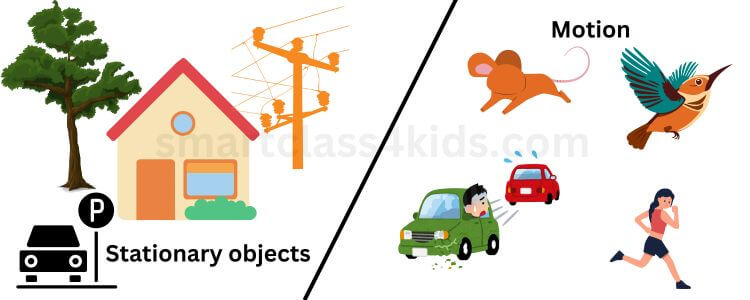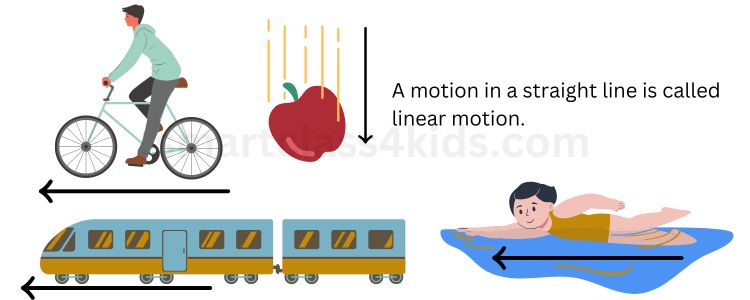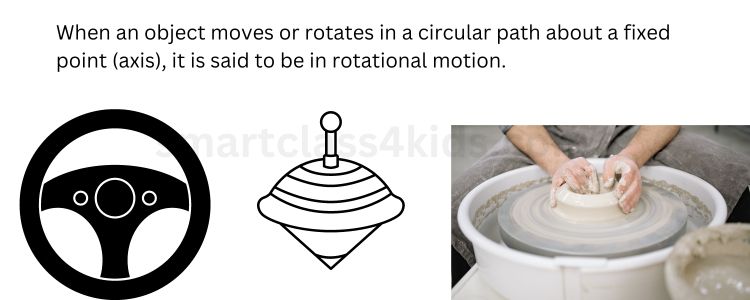Types of Motion

What is motion?
The movement of an object is called motion. Let’s understand motion with an example. A tree always remains in one place; similarly, a building, a table, or a chair remain in one place until they are lifted and placed in another place. On the other hand, humans, animals, birds, cars, etc. do not remain fixed at one place; rather, they move from one place to another. We can say that whenever an object changes its position with time, there is movement in it, and this movement of the object is called motion.
So, an object is in motion when its position changes with time. Similarly, when an object remains stationary at one place, it is called at rest in science.
For example, a parked car is said to be at rest. But when the car is moving, it is said to be in motion.
Types of motion
- Linear motion
- Circular motion
- Oscillatory motion
- Rotational motion
- Uniform motion
- Non-uniform motion
- Periodic motion
What is Linear motion?

A motion in a straight line is called linear motion. It takes place in a fixed direction without any divergence.
Below are some examples of linear motion:
- the motion of a car on a straight road
- motion of a train on a straight railway track
- swimming in a straight line
- the motion of a kid sliding down a slope
- free falling any object
- falling fruits from tree
- rolling a ball on ground
- marching past of soldiers in a parade
What is circular motion?

A circle-shaped path is called a circular path. When an object moves on a circular path, it is called circular motion.
Below are some examples of circular motion:
- The motion of a giant wheel
- A satellite orbiting the Earth
- The moon moves around the earth
- Hands of a clock
- A stone was tied with a string and rotated.
What is oscillatory motion?

When an object repeats the same movement over and over, this is called oscillatory motion.
Below are some examples of oscillatory motion:
- pendulum of a clock
- swinging in the park
- movement in spring
- rocking cradle or rocking chair
- flapping wings by birds
What is rotational motion?

When an object moves or rotates in a circular path about a fixed point (axis), it is said to be in rotational motion. There is difference between rotational motion and circular motion. In circular motion, an entire object moves along a circular path, but in rotational motion, the object rotates around its axis.
Below are some examples of rotational motion:
- spinning top
- spinning of earth on its axis
- rotation of a wind mill
- potters wheel
- cars steering wheel
- turning a merry-go-round (as a whole)
What is uniform motion?

When an object moves in a straight line at a constant speed, this is called uniform motion. It means the velocity of the body remains the same as it travels equal distances in equal time intervals.
Below are some examples of uniform motion:
- A moving train at a constant speed along a straight track
- A boy running in a straight path with constant speed
- A sewing machine’s vibrating spring
What is non- uniform motion?
When an object moves by changing its velocity with time, it is called non-uniform motion. Non-uniform motion is also called accelerated motion.
For example, a car travels 50 miles in the first hour, 100 miles in the second hour, and so on. Thus, a moving car will cover a smaller distance in the first ‘1 hour’ and a larger distance in the subsequent ‘1 hour’ intervals. Therefore, we can say that the motion of the car is an example of non-uniform motion.
What is periodic motion?
The motion that repeats in equal intervals of time is called periodic motion. The revolution of the earth around the sun is an example of periodic motion because it takes the same amount of time to complete one round of the sun. The rotation of the earth on its axis, the revolution of the moon around the earth, and the swinging of a pendulam are also examples of periodic motion.
